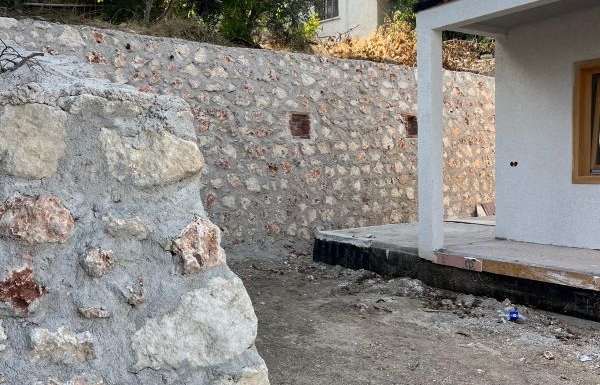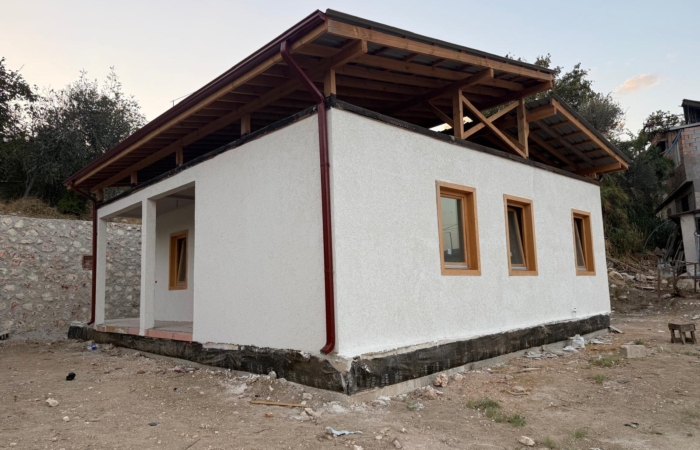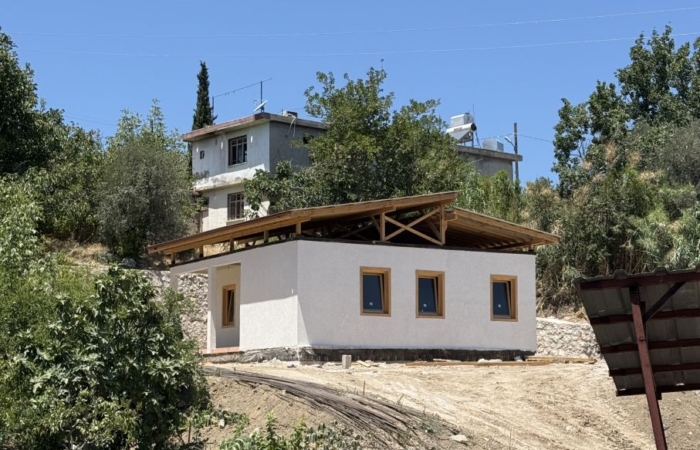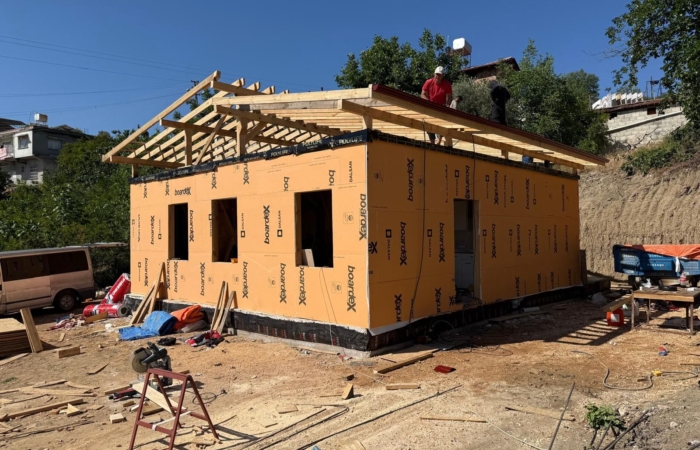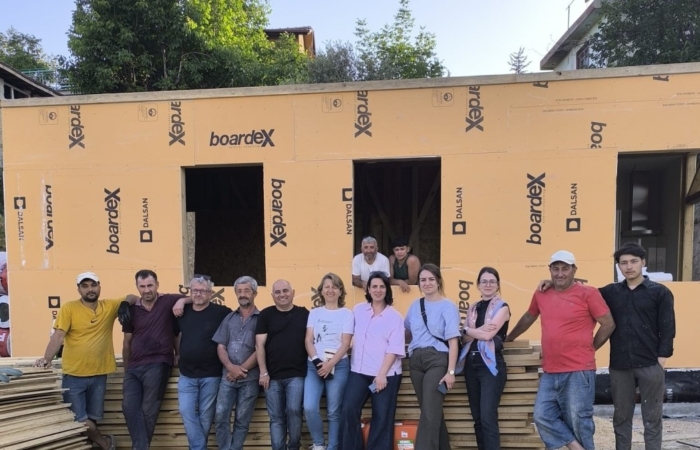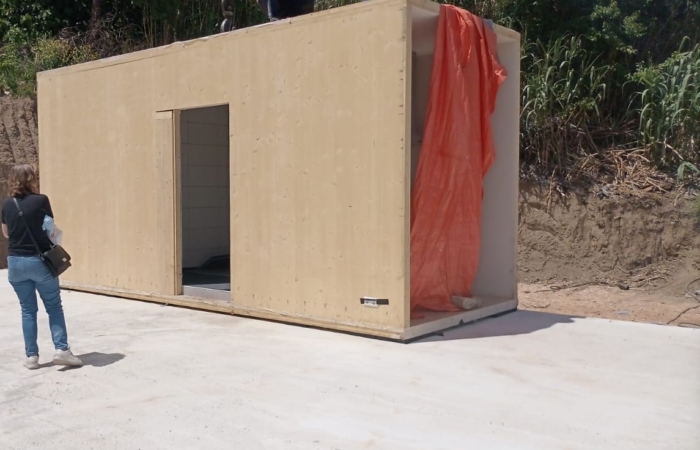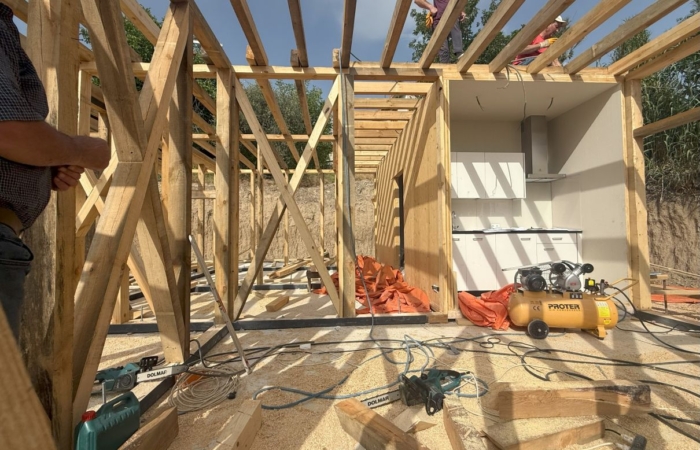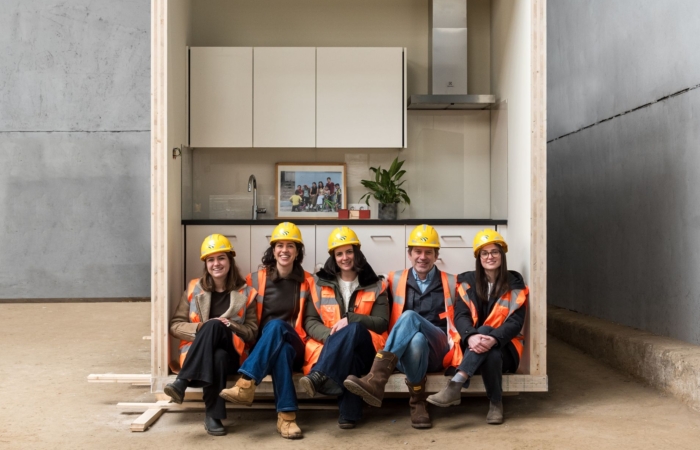ART Architectural Recovery team
What is the Architectural Recovery Team, and what do you stand for?
The Architectural Recovery Team (ART) is a foundation that originated at TU Delft, initially as a student initiative and now grown into an interdisciplinary team of seven women with backgrounds in architecture, urban planning, and building engineering. Our goal is to contribute to the reconstruction efforts following the devastating earthquakes of February 2023 in Hatay, Türkiye.
We developed a prototype family home that offers a safe and sustainable future for a family in a village near Antakya. The design consists of a Core Unit and Room Units. The Core Unit, made of cross-laminated timber (CLT), houses the bathroom, kitchen, and technical systems. It is compact, earthquake-resistant, and largely self-sufficient in terms of electricity, water, and heating — essentially functioning as a safe house.
The Core Unit was first constructed in the Netherlands, in the Urban Miner workshop in Dordrecht, allowing us to test the design in a controlled environment. It was then transported by truck to Hatay and placed on its foundation, where local contractors built the Room Units — the living spaces — around the core.
The first completed house was donated to a family of seven who lost everything in the earthquake. With this prototype, we are not only helping affected families but also developing a system that can be applied globally in disaster recovery: a core that can be produced and transported quickly, immediately providing a safe base for a family while also forming the foundation for a complete long-term home.
What does a project day look like — from planning to reconstruction?
In recent months, our focus has been on building our first prototype. Our work is highly diverse: from team meetings to on-site coordination and negotiations. We source materials, collaborate with local contractors, and work with authorities on essentials such as sewage and electrical connections. These efforts often involve many conversations — and cups of coffee — which are exactly what make local cooperation and long-term trust possible.
What challenges do you often face, and how do you overcome them?
A project like this involves numerous challenges — logistics, for example, from transporting the Core Unit to Türkiye to sourcing the right materials locally, or unexpected issues at the construction site, such as damage or delays. We handle these by staying flexible, working with reliable partners, and supporting each other within the team. Often, it’s a matter of creative thinking and effective negotiation with local stakeholders.
Can you give an example of a building or community that has come back to life thanks to your work?
The house we built is now home to a family of seven, including a newborn baby. After the earthquake, they had been living in a former storage space without their own bathroom or kitchen. Thanks to our project, they now have a safe, dignified home on their own land — designed with sufficient space and the possibility to expand in the future.
Importantly, this project shows that people don’t need to leave their villages to rebuild safely. Many affected families were offered apartments in the city, but for rural residents, that’s a difficult transition — it means leaving behind their land, neighbors, and way of life. Our prototype demonstrates that safe and sustainable reconstruction within the community is possible.
What role did the Corendon Foundation play in this project?
The support of the Corendon Foundation was crucial. Their contribution of €40,000 enabled us to finance a significant portion of the construction. Thanks to this support, the prototype could be realized.
Our work focuses on three main goals:
Safe and sustainable reconstruction – developing affordable, earthquake-resistant housing that fits the local context.
Collaboration with local communities – involving families and villages in the process to ensure that the homes meet their cultural and practical needs.
Knowledge sharing – documenting and sharing lessons learned so that other disaster-affected regions can benefit.
What does this work mean for the local community — how do they respond?
From the very beginning, we spoke with local residents to understand their needs. We noticed that many existing reconstruction projects didn’t reflect real-life situations — for example, some houses weren’t wheelchair-accessible even when families required it. Our design is consciously inclusive and adaptable.
The reactions have been overwhelmingly positive. Residents feel heard and valued, and they’re grateful for a solution that allows them to stay in their own village. Local builders and craftsmen are eager to contribute and proud to help rebuild their own region.
What are you most proud of personally?
We’re proud that we actually turned our idea into reality. What began as a student initiative became a tangible home for a real family. There was no blueprint to follow, no clear roadmap — and along the way, we faced many obstacles. Yet we persevered. Our academic knowledge gave us confidence in the safety of our design, and step by step, we proved that it was both feasible and effective.
That’s what makes us proud: through determination and collaboration, we’ve created something that makes a real difference.
What are your plans for the coming period?
Over the next few years, we will continue monitoring the prototype to see how it performs and where improvements can be made. We aim to refine the design further and work with local partners in Türkiye to explore local production of wooden homes.
Since there is currently no CLT factory in Türkiye, we’re studying the possibilities of establishing one locally — reducing both transport costs and CO₂ emissions.
We’re also receiving growing interest from other families and organizations. Our goal is to scale up from a single prototype to broader production and to establish a knowledge platform that can guide future reconstruction projects in Türkiye and beyond.
How can others contribute or get involved?
There are several ways individuals or organizations can support us. Financially, contributions through crowdfunding help us fund key moments such as the official opening in Türkiye. But we also welcome collaboration in the next stages of our project — developing the knowledge platform, refining the design, or expanding production capacity.
Together, we can ensure that more families affected by disasters regain what everyone deserves: a safe place to call home.

